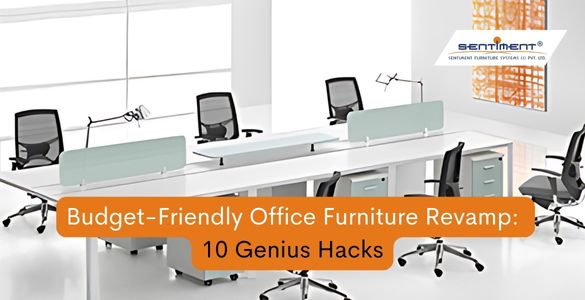
Anil Sharma (April 30, 2024 AT 4.00 PM)
In the modern era, where workplaces are evolving rapidly to accommodate diverse needs and foster creativity and productivity, the significance of office furniture design cannot be overstated. Beyond mere functionality, office furniture plays a crucial role in shaping the ambiance, culture, and efficiency of a workspace. This comprehensive guide delves into the nuances of office furniture design, exploring its evolution, principles, trends, and practical considerations.
Office furniture design has
come a long way from its utilitarian roots to embrace a blend of functionality, aesthetics, and
ergonomics. Historically, office spaces were characterized by rigid, hierarchical layouts with bulky
desks and chairs, reflecting a mechanistic approach to work. However, with the advent of concepts like
open offices, co-working spaces, and remote work, furniture design has undergone a paradigm shift.
Early innovations, such as the ergonomic chair by Herman Miller in the 1970s, marked a turning point by
prioritizing comfort and support. Today, office furniture is designed to promote collaboration,
flexibility, and well-being. From standing desks and ergonomic seating to modular workstations and
space-saving solutions, contemporary designs cater to the diverse needs of modern workplaces.
Effective office furniture design is guided by several key principles aimed at enhancing functionality, comfort, and aesthetics:
Ergonomic design prioritizes user comfort and health by ensuring furniture supports natural body postures, minimizes strain, and promotes movement. Adjustable chairs, sit-stand desks, and monitor arms are examples of ergonomic solutions.
Furniture should facilitate various work activities seamlessly. Modular furniture systems allow for customization and adaptation to changing needs, while integrated storage solutions maximize space utilization.
Office furniture contributes to the visual identity and atmosphere of a workspace. Designs that incorporate clean lines, neutral colors, and natural materials create a contemporary, inviting environment conducive to productivity and creativity.
Flexible furniture arrangements accommodate different work styles and activities, fostering collaboration, focus, and privacy as needed. Mobile furniture, movable partitions, and multi-purpose pieces enhance adaptability in dynamic work environments.
High-quality materials and construction ensure longevity and resilience, reducing the environmental impact of furniture production and disposal. Sustainable practices, such as using recycled materials and designing for disassembly, promote responsible consumption.
Office furniture design is subject to ongoing trends reflecting societal shifts, technological advancements, and evolving work practices. Some prominent trends include:
Integrating elements of nature into the workspace, such as living plants, natural light, and organic materials, to enhance well-being, creativity, and connection to the environment.
Embracing agile principles, furniture designs support flexibility, collaboration, and rapid adaptation to changing needs through modular, reconfigurable solutions.
With the rise of remote work, furniture designs cater to home office setups, offering compact, versatile solutions that promote comfort and productivity in diverse environments.
Blurring the boundaries between residential and commercial aesthetics, resimercial furniture designs create a warm, home-like atmosphere in the workplace, promoting relaxation and a sense of belonging.
Incorporating IOT (Internet of Things) technology, smart furniture features enable connectivity, personalization, and data-driven insights to optimize user experience and space utilization.
When choosing office furniture, several practical considerations should be taken into account to ensure alignment with organizational goals and user needs:
Establishing a budget helps prioritize furniture options and select solutions that offer the best value in terms of quality, functionality, and aesthetics.
Assessing available space and considering workflow requirements inform furniture layout and configuration to optimize space utilization and circulation..
Soliciting input from employees regarding their preferences, ergonomic requirements, and work habits promotes user satisfaction and engagement with the workspace.
Ensuring furniture meets ergonomic standards and safety regulations protects employee health and minimizes the risk of workplace injuries.
Choosing furniture that reflects the organization's brand values and culture reinforces identity and fosters a sense of belonging among employees.
In conclusion, office furniture design plays a pivotal role in shaping the modern workplace, balancing functionality, aesthetics, and user well-being. By embracing ergonomic principles, incorporating innovative trends, and considering practical considerations, organizations can create work environments that inspire creativity, foster collaboration, and support employee satisfaction and productivity. As workplaces continue to evolve, the art and science of office furniture design will remain integral to creating spaces that adapt to changing needs and empower individuals to thrive.
A1: Ergonomic office furniture promotes user comfort, reduces the risk of musculoskeletal disorders, enhances productivity, and supports overall well-being by aligning with natural body mechanics.
A2: Furniture designs that facilitate flexibility, mobility, and interaction, such as modular workstations, communal tables, and flexible seating arrangements, encourage collaboration and teamwork among employees.
A3: Key considerations for office chairs include ergonomic features (adjustable height, lumbar support, recline function), durability, aesthetics, and compliance with ergonomic standards (e.g., ANSI/BIFMA).
A4: To create an ergonomic home office setup, consider investing in a comfortable chair with adjustable features, a height-adjustable desk or converter for standing options, proper lighting, and accessories like monitor arms and keyboard trays to promote neutral posture.
A5: Sustainable office furniture practices include using environmentally friendly materials (e.g., FSC-certified wood, recycled content), designing for longevity and recyclability, minimizing packaging waste, and selecting products from manufacturers committed to sustainability.

Office Furniture Design: Crafting Workspaces for Productivity and Comfort

Luxury Office Chairs in India

Luxury Executive Office Chairs

Professional Office Luxury Boss Office Table Design

Modern VIP Luxury Boss Office Table Design

Small Office Boss Cabin Design

Comfort & Style: Finding the Perfect Office Furniture in Hyderabad

Office Furniture Manufacturers: Choosing Quality, Comfort, and Style for Your Workspace

10 Genius Hacks to Revamp Your Office Furniture on a Budget

10 Genius Hacks to Revamp Your Office Furniture on a Budget
.jpg)
Find quality & affordable modular office furniture?

Transform Your Office With Stylish Furniture